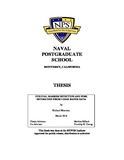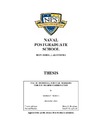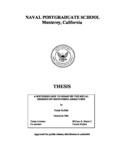Fiducial marker detection and pose estimation from LIDAR range data

Download
Author
Morrison, Richard B.
Date
2010-03Advisor
Kolsch, Mathias
Chung, Timothy H.
Metadata
Show full item recordAbstract
Light Detection and Ranging (LIDAR) systems are three dimensional (3D) imaging sensors applied for mapping terrain, measuring structural dimensions, and navigating robots. Pulsed laser rangefinders provide precise range measurements that require an estimate of sensor pose for transformation into world coordinates. Pose information is frequently provided with extrinsic sources such as Global Positioning System (GPS) or an Inertial Measurement Unit (IMU). Unreliable signal availability for GPS in military environments and the high cost of IMUs limit the employment of these extrinsic sources. Determining pose intrinsically by detecting landmarks in the environment within the sensor data is more ideal. Fiducial markers with known geometric dimensions and orientation provide a means of estimating LIDAR pose and registering data. Presented is a method for landmark detection and pose estimation within range data. Cylinder, cone, and sphere geometries are assessed for use as fiducial markers. The detection algorithm extracts geometric features from LIDAR point data and tests for fit to a fiducial marker model. Geometric feature extraction compresses the data set and leads to a potential intrinsic registration method using environment and marks. The detection accuracy and pose estimation precision are examined with terrestrial LIDAR range data captured in various outdoor street environments.
Rights
This publication is a work of the U.S. Government as defined in Title 17, United States Code, Section 101. Copyright protection is not available for this work in the United States.Related items
Showing items related by title, author, creator and subject.
-
USE OF ARTIFICIAL FIDUCIAL MARKERS FOR USV SWARM COORDINATION
Heubach, Matthew J. (Monterey, CA; Naval Postgraduate School, 2022-12);Typical swarm algorithms (leader-follower, artificial potentials, etc.) rely on knowledge about the pose of each vehicle and inter-vehicle proximity. This information is often obtained via Global Positioning System (GPS) ... -
FEASIBILITY OF USING ACTIVE FIDUCIAL MARKERS FOR UUV NAVIGATION AND LOCALIZATION
McClain, Richard T. (Monterey, CA; Naval Postgraduate School, 2019-12);Fiducial markers are widely used for ground and air robot localization and navigation. The markers provide a tertiary reference for the robot when Global Positioning System (GPS) and inertial navigation are unreliable. ... -
A methodology to measure the metal erosion on recovered armatures
Gurhan, Ozkan. (Monterey, California. Naval Postgraduate School, 2001-12);Metal erosion on railgun armatures is a life-limiting mechanism for electromagnetic guns. A methodology to measure the eroded metal and to plot erosion contours on the armatures would be helpful for optimization and ...


 10Mar_Morrison.pdf (3.725Mb)
10Mar_Morrison.pdf (3.725Mb)

